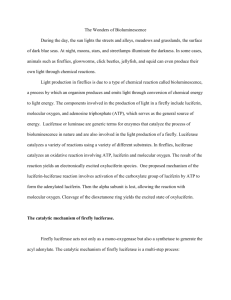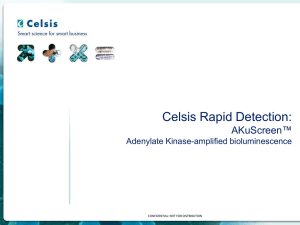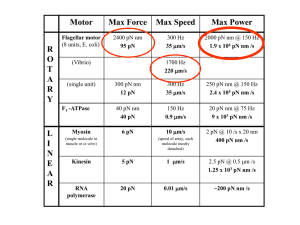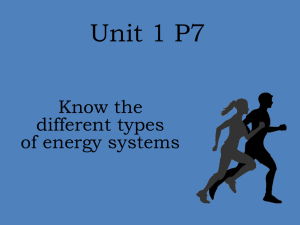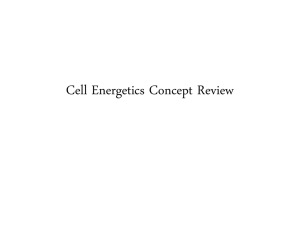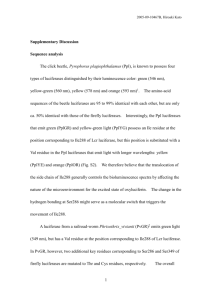Bioluminescence: Luciferin-Lucferase ATP Detection Assay
advertisement
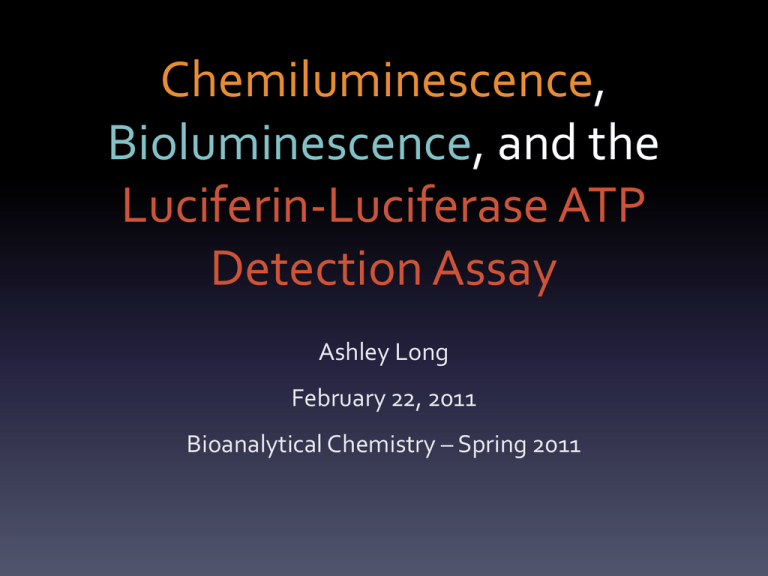
Chemiluminescence, Bioluminescence, and the Luciferin-Luciferase ATP Detection Assay Ashley Long February 22, 2011 Bioanalytical Chemistry – Spring 2011 Overview • Background on Chemiluminescence and Bioluminescence • General overview of uses of Bioluminescence in High-Throughput Screening (HTS) • Introduction to the Luciferin-Luciferase ATP detection assay and its importance in HTS The firefly Image from: http://scienceline.org/2010/11/lighting-the-way/ What is chemiluminescence? • Occurs when an EXOTHERMIC CHEMICAL reaction releases energy to generate electromagnetic radiation which gives off light 1,2 • Types1: – Reactions with synthetic compounds (i.e. H2O2) – Bioluminescent reactions – from a living organism – Electrochemiluminescent reactions – use electric current minescence. However, because more photons can be collected from macroscopic samples, reducing background associated with the assay method becomes more important. This is the case for assays performed in multiwell plates, where chemiluminescent assays often outperform analogous fluorescent assays.2,3 The low background inherent in chemiluminescence allows for a better signalto-noise ratio and thus better assay sensitivity. Such Fluorescence macroscopic measurements are the foundation for most HTS methods, which rely heavily on the use of multi• Light must be absorbed by across well plates to rapidly measure a single parameter a large number of samples. Furthermore, fluorescent asfluorophore tothereach excited state says can also be affected by presence of interfering fluorophores within the biological samples or in the liBrighter, but MORE background brary •compounds, whereas chemiluminescence is less hindered. Firefly (Photinus pyralis) luciferase is a monomeric enzyme of 61 kDa that requires no posttranslational modifications for activity.4 It acts by first combining beetle luciferin with ATP, to form luciferyl-AMP as an enzymebound intermediate. This intermediate reacts with O2 to create another bound intermediate, oxyluciferin, in a high-energy state. The subsequent energy transition to the ground state yields yellow-green light with a spectral Chemiluminescence maximum of 560 nm (Fig. 2). Renilla luciferase from the sea pansy Renilla reni• See energy gain through formis is a 36-kDa monomeric enzyme that catalyzes the oxidation of coelenterazine to yield coelenteramide and chemical reaction blue light with a spectral maximum of 480 nm.5 It has been used primarily as a co-reporter in conjunction with • Lower signal (intensity), firefly luciferase. For HTS, it is used in but a duallittle luciferase format to provide an internal control for identifying aber- More on Chemiluminescence to NO background = beter S/N FIG. 1. Comparison of fluorescence (left) to luminescence (right). S0, ground state; S1, excited state after vibrational relaxation; S2, excited state. (Figure 1) Citation 2 What is bioluminescence? • A type of chemiluminescence that occurs in living organisms • Enzyme catalyzed reactions – Enzymes: luciferases • Firefly luciferase • Renilla luciferase (sea pansy) • Aequorin (jellyfish- Aequorea victoria) – Substrates (photon-emitting): luciferins Citation 2; Image taken fromhttp://www.biosynth.com/index.asp?topic_id=119 Firefly Bioluminescence • Light Intensity ~ Chemical Concentration – [Chemical] of interest can be ATP, luciferin, or luciferase (hold all others constant) – Very large linear range • Most common luciferase used in the development of High-Throughput Screening (HTS) Assays Citation 2 Firefly Luciferase Catalyzed Rxn Yellow-green light λmax = 560 nm (Figure 2) Citation 2 How do you detect the signal? The GloMax® 20/20 Luminometer is designed to provide ultrahigh performance for bioluminescent and chemiluminescent assays. In addition to high performance, the GloMax® 20/20 blends user-friendly operation and a small footprint with flexible purchasing options. The result of this design is an instrument with superior performance that is easy to use, affordable, and can be customized to your lab’s needs.3 The GloMax®-96 Microplate Luminometer is a state-of-the-art microplate luminometer that meets the requirement for high sensitivity and broad dynamic range that is necessary for chemiluminescent and bioluminescent applications. With optional Single or Dual Auto Injectors, the GloMax®-96 is a versatile luminescence system capable of performing both flash and glow-type luminescent assays.3 Citation 3 How can this reaction be used in HTS? 130 Fan and Wood (Figure 3) Citation 2 ™ 130 HTS: Luciferase Concentration Fan and Wood • Goal: investigate intracellular events by monitoring gene transcription • May include internal control (dual-luciferase assay) • Simple and efficient (HTS) • Commonly used for GPCR and nuclear receptor assays (Figure 3) Citation 2 HTS: Luciferin Concentration FIG. 3. Bioluminescent assays for HTS. luc, firefly luciferase gene; Ultra-Glo ™ rLuciferase, stable recombinant firefly luciferase (Promega, Madison, WI); MAO, monoamine oxidase. • Luciferin is not naturally linked to physiology (vs. ATP) • Use a Pro-luciferin nilla luciferase) can help mitigate these false hits and imAn alternative strategy for generating dual luciferase prove data quality. However, introducing both reporters assays was developed based on a standard two-plasmid into the cell on the same plasmid backbone can result in approach (Fig. 4). One plasmid features both a firefly lu– Enzyme interest must convert luciferin linkelement of interaberrant expression due to of cross interference between ciferasethis geneto regulated by the response promoters and response elements (authors’ unpublished est (e.g., CRE or NFAT) and a hygromycin-selectable luminescent signal to enzymemarker. of interest data). The second plasmid expresses the target GPCR FIG. 4. A diagram of two plasmids involved in the dual-luciferase assay of GPCRs. RE, response (Figure 3) Citation 2 HTS: ATP Concentration • Enzyme must be consistent! Often use “stabilized” luciferase enzymes for HTS • Used in: – Cytotoxicity screens ATP concentrations ~ cell viability – Kinase activity screens all kinases consume ATP in phosphorylation rxn – Real-time detection of ATPase activity4 – FIG. 3. Bioluminescent assays for HTS. luc, firefly luciferase gene; Ultra-Glo ™ rLuciferase, stable recombinant firefly luciferase (Promega, Madison, WI); MAO, oxidase. faster than some dye assays used to look at cell ~ 100X more sensitive andmonoamine significantly metabolism nilla luciferase) can help mitigate these false hits and improve data quality. However, introducing both reporters into the cell on the same plasmid backbone can result in An alternative strategy for generating dual luciferase assays was developed based on a standard two-plasmid approach (Fig. 4). One plasmid features both a firefly lu- (Figure 3) Citation 2 Examples of HTS assays • Luciferase Enzymatic Activity monitoring assays2 – Sensitive & broad detection range • Protein- Protein interaction assays5,6 – BRET – Bioluminescence resonance energy transfer – PCA – Protein fragment complementation assay • Real-time bioluminescence to analyze inhibitors of polymerases (DNA & RNA)7 (Figure 2) Citation 6 Examples of HTS assays • BL/CL recombinant whole-cell biosensors – Genetically engineered cells – Create a luminescent signal ~ to a specific analyte (analyte should be regulating gene expression) – Used for monitoring: • Stress, oxidants, metals, xenobiotics, receptor activating molecules, etc. (Figure 5), Citation 6 ATP Assay Kit - Demonstration • ATP Determination Kit – Molecular Probes (Invitrogen ) – Bioluminescence assay – Quantitative determination of ATP concentrations – Components: • Recombinant firefly luciferase (enzyme) • D-luciferin (substrate) (Mg2+) (luciferase) Luciferin + ATP + O2 oxyluciferin + AMP + pyrophosphate + CO2 + light Citation 8 ATP Assay – Standards ATP Determination Kit • Advantages: – Very sensitive – Detect down to ~ 0.1 picomoles of ATP (must create a standard curve within the desired range) – Readily available & affordable • Uses: – Versatile (can be used to look at ATP production in different enzymatic reactions) – NADPH, ATPase – Detect contamination in a range of samples (milk, blood, sludge, etc.) – Many others! Citation 8 We can detect ATP. So what? • ATP is required for cellular metabolism9 • “… each human being recycles the equivalent of his/her own mass of ATP every day.”9 • Extracellular ATP concentrations are critical in biological receptor response10 Image from: http://www.bris.ac.uk/Depts/Chemistry/MOTM/atp/atp1.htm Areas of interest for ATP quantitation • The Mitochondria – the “powerhouse” of the cell – Complex system – ATP is produced and sent to the cell • Implications in cardiomyopathies Mitochondrial ADP/ATP Carrier (Figure 1) Citation 9 Rapid Hygiene Tester (Biothema) • Detect ATP (quickly) down to very low detection – i.e. ATP in one animal cell (~ 1 pg) • Also developed to test AMP as well (bi-product of ATP breakdown) • Important in the food production industry, labs, hospitals, etc. Citation 11 Conclusions • Chemiluminescence and Bioluminescence are common, extremely versatile, and useful analytical tools • HTS methods are becoming increasingly more dependent upon this “background-free” technique • The ATP Detection Assay could have huge implications in pharmacology as it evolves for different types of detection Works Cited 1. "Chemiluminescence." Lumigen, INC - A Beckman Coulter Company. Web. 07 Feb. 2011. <http://www.lumigen.com/detection_technologies/chemiluminescence/>. 2. Fan, Frank, and Keith V. Wood. "Technology Review: Bioluminescent Assays for High-Throughput Screening." ASSAY and Drug Development Technologies 5.1 (2006): 127-36.Fan, Frank and Wood V. Keith. ASSAY and Drug Development Technolgoies. V5, N1. 2007. 3. "Luminometer Comparison Chart of Microplate/Multiwell and Single Tube Luminometers from Promega." Promega Luminometers, Fluorometers, and Multimode Readers. Web. 07 Feb. 2011. http://www.luminometer.com/instruments/luminometers-dual-luciferaseATP-ELISA.php?gclid=CIel3d-r9qYCFYbb4Aodw3MjFg. 4. Karamohamed, Samer, and Guido Guidotti. "Bioluminometric Method for Real-Time Detection of ATPase Activity." BioTechniques 31 (2001): 420-25. 5. Hoshino, Hideto. "Current Advanced Bioluminescence Technology in Drug Discover." Expert Opinion in Drug Discovery 4.4 (2009): 37389. 6. Roda, Aldo, Patrizia Pasini, Mara Mirasoli, Elisa Michelini, and Massimo Guardigli. "Biotechnological Applications of Bioluminescence Adn Chemiluminescence." TRENDS in Biotechnology 22.6 (2004): 295-303. 7. Gregory, Kalvin J., Ye Sun, Nelson G. Chen, and Valeri Golovlev. "Real-time Bioluminescent Assay for Inhibitors of RNA and DNA Polymerases and Other ATP-dependent Enzymes." Analytical Biochemistry 408 (2011): 226-34. 8. "ATP Determination Kit (A22066)." Product Information: Molecular Probe: Invitrogen detection technologies. Revised 29-Nov-2005. 9. Dahout-Gonzalez, C., H. Nury, V. Trezequet, J. M. Lauquin, E. Pebay-Peyroula, and G. Brandolin. "Molecular, Functional, and Pathological Aspects of the Mitochondrial ADP/ATP Carrier." PHYSIOLOGY 21 (2006): 242-49. 10. Seminario-Vidal, Lucia, Eduardo R. Lazarowski, and Seiko F. Okada. "Assessment of Extracellular ATP." Bioluminescence, Methods in Molecular Biology 574 (2009): 25-36. 11. "Can You Say It's Clean with Confidence?" BioThema - Luminescence Analysis, We Sell Our Kits and Reagents Worldwide. Web. 14 Feb. 2011. <http://www.biothema.com/news_newsdetail.do;jsessionid=A047393FA5453A636E59B387B9B173B6?newsentryid=12〈=en>. Works Cited – Other Helpful Websites • http://uvminerals.org/fms/luminescence – Great website which clarifies VERY well the differences in luminescence • http://www.photobiology.info/Branchini.htm – Great website to visit if you want a better understanding of the chemistry mid backbone can result in ross interference between ents (authors’ unpublished approach (Fig. 4). One plasmid features both a firefly luciferase gene regulated by the response element of interest (e.g., CRE or NFAT) and a hygromycin-selectable marker. The second plasmid expresses the target GPCR Example of QC in GPCR assay mids involved in Rs. RE, response bilized and optiPro-Glu-Ser-Thr n virus 40 pronce gene; PCMV, Neor, Renilla luce gene fusion. with rapidly de- • Dual-Luciferase assay – Helps to account for interferences (i.e. from cytotoxic compounds) which could effect results (false -/+’s) – Plasmid 1 – firefly luciferase gene, marker, and response element of interest – Plasmid 2 – GPCR of interest and Renilla luciferase marker fusion protein (Figure 4) Citation 2 Example of Luciferin Detection (comparing fluorescence and bioluminescence) (Figure 7) Citation 2 Example of an Actual ATP Standard Curve using an ATP Detection Kit 1600 Standard Curve at 560 nm 1400 Luminescence 1200 y = 1E+09x + 43.478 R² = 0.99675 1000 800 600 400 200 0 -2.00E-07 0.00E+00 2.00E-07 4.00E-07 6.00E-07 8.00E-07 Concentra on of ATP (M) 1.00E-06 1.20E-06
